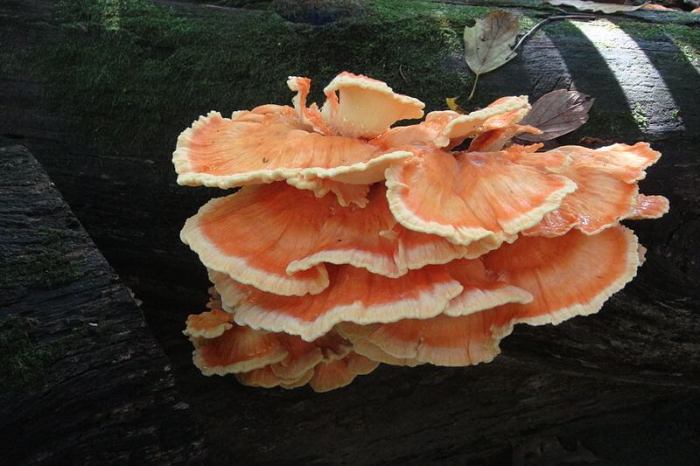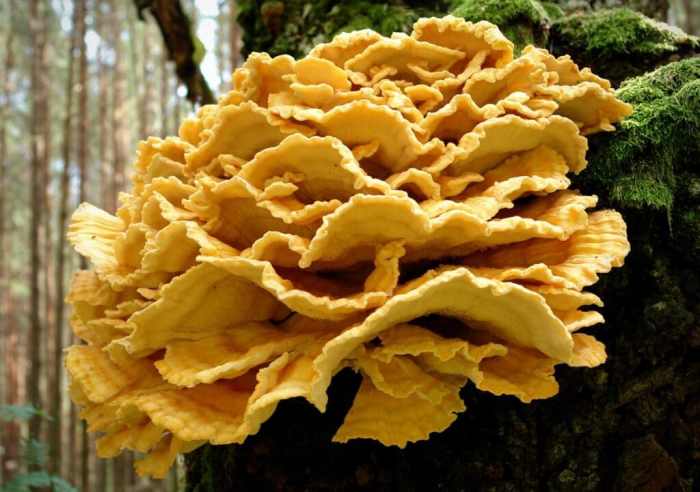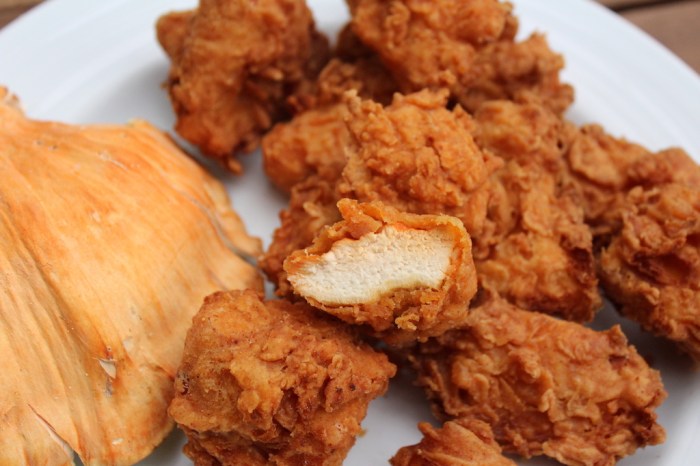
Chicken of the woods recipe – Welcome to the enchanting world of chicken of the woods! This vibrant mushroom, with its captivating colors and succulent texture, has been a culinary treasure for centuries. Join us as we explore the depths of its culinary applications, nutritional benefits, and the art of foraging and preparing this delectable delicacy.
Culinary Applications

Chicken of the woods is a versatile culinary mushroom that can be incorporated into a wide range of dishes, from hearty soups and stews to savory pasta sauces and grilled skewers. Its meaty texture and mild, slightly nutty flavor make it an excellent substitute for chicken or other meats in many recipes.
Chicken of the woods can be cooked using various methods, including sautéing, grilling, and roasting. Sautéing is a quick and easy way to prepare the mushroom, resulting in a tender and flavorful dish. Grilling gives the mushroom a smoky flavor, while roasting caramelizes its exterior and intensifies its sweetness.
Complementary Cuisines and Ingredients
The flavor profile of chicken of the woods complements a variety of cuisines, including Italian, French, and Asian. It pairs well with bold flavors such as garlic, rosemary, thyme, and paprika. Chicken of the woods also goes well with vegetables such as onions, peppers, and tomatoes, and can be used to make hearty soups and stews.
Nutritional Benefits

Chicken of the woods is a nutritional powerhouse, boasting an impressive composition of protein, fiber, and essential nutrients. Its high protein content makes it an excellent meat alternative for vegetarians and vegans, while its abundance of fiber aids in digestion and promotes satiety.
Antioxidant and Anti-inflammatory Properties
Beyond its macronutrient profile, chicken of the woods is also a rich source of antioxidants and anti-inflammatory compounds. These compounds help protect the body from oxidative stress and reduce inflammation, which may contribute to various chronic diseases. Incorporating chicken of the woods into a balanced diet can potentially support overall health and well-being.
Incorporating into a Healthy Diet
To reap the nutritional benefits of chicken of the woods, it can be incorporated into various culinary preparations. It can be sautéed, roasted, grilled, or added to soups, stews, and salads. When cooking chicken of the woods, it is important to remove the tough base before consumption.
Additionally, due to its high fiber content, it is recommended to consume it in moderation to avoid potential digestive discomfort.
Identification and Foraging

Chicken of the woods, a striking edible fungus, is known for its vibrant hues and unique appearance. Identifying and foraging for this mushroom requires keen observation and an understanding of its characteristics and habitat preferences.
Distinctive Physical Characteristics
Chicken of the woods exhibits a vibrant orange or yellow color, often with a scalloped or ruffled appearance. Its texture resembles that of chicken meat, giving it a chewy and tender consistency. The mushroom grows in clusters or shelves on the sides of trees, particularly oaks and beeches.
Optimal Foraging Conditions
Chicken of the woods typically fruits in late summer and fall, after a period of heavy rainfall. Foraging during these seasons increases the chances of finding fresh and abundant mushrooms. The best locations to search for chicken of the woods are moist woodlands, especially those with decaying logs or stumps.
Identification Tips
To ensure safe foraging, it’s crucial to distinguish edible chicken of the woods from its look-alikes. Look for the characteristic orange or yellow color, ruffled edges, and lack of gills on the underside. Avoid mushrooms with a strong odor or bitter taste, as these may be toxic.
Preparation and Preservation: Chicken Of The Woods Recipe

Chicken of the woods, with its unique texture and savory flavor, requires proper preparation and preservation techniques to ensure optimal culinary experiences. This section delves into the steps involved in preparing chicken of the woods for cooking, including cleaning, cutting, and marinating.
Additionally, it discusses various preservation methods such as drying, freezing, and pickling, highlighting their effectiveness in extending the shelf life of this delectable fungus.
Cleaning
Cleaning chicken of the woods is crucial to remove any dirt, debris, or insects that may have attached themselves during its growth. Gently brush away any loose particles with a soft-bristled brush or a damp cloth. For larger specimens, cut them into smaller pieces to facilitate thorough cleaning.
Avoid washing chicken of the woods with water, as it can absorb moisture and compromise its texture.
Cutting
Once cleaned, cut the chicken of the woods into desired shapes and sizes. Depending on the intended cooking method, you can slice it into strips, cubes, or bite-sized pieces. Thinner cuts will cook faster, while thicker pieces require longer cooking times.
Use a sharp knife to ensure clean cuts and minimize tearing.
Marinating
Marinating chicken of the woods is an optional step that can enhance its flavor and tenderness. Prepare a marinade of your choice, incorporating ingredients such as olive oil, herbs, spices, or citrus juices. Submerge the chicken of the woods in the marinade for at least 30 minutes, or up to overnight for deeper flavor penetration.
Discard the marinade before cooking.
Drying, Chicken of the woods recipe
Drying chicken of the woods is an effective preservation technique that removes moisture and inhibits spoilage. Slice the chicken of the woods thinly and spread it on a baking sheet lined with parchment paper. Place the baking sheet in a warm, dry place with good air circulation.
Alternatively, you can use a food dehydrator to accelerate the drying process. Once completely dry, store the dried chicken of the woods in an airtight container in a cool, dark place for up to a year.
Freezing
Freezing is another viable preservation method for chicken of the woods. Blanch the chicken of the woods by boiling it for 2-3 minutes, then immediately transfer it to an ice bath to stop the cooking process. Once cooled, drain the chicken of the woods thoroughly and pat it dry.
Place the chicken of the woods in freezer-safe bags or containers and freeze for up to 6 months.
Pickling
Pickling chicken of the woods involves preserving it in a vinegar-based solution. Slice the chicken of the woods thinly and pack it into a jar. Create a pickling liquid by combining vinegar, water, sugar, and spices in a saucepan and bringing it to a boil.
Pour the hot pickling liquid over the chicken of the woods, ensuring it is completely submerged. Seal the jar and let it cool to room temperature before refrigerating. Pickled chicken of the woods can be stored in the refrigerator for several months.
Storage and Handling
Proper storage and handling of chicken of the woods are essential to extend its shelf life. Fresh chicken of the woods should be stored in a paper bag or wrapped in a damp paper towel and refrigerated for up to 5 days.
If you’re looking for a more adventurous recipe, try this chicken of the woods recipe . It includes ingredients like smoked paprika and roasted garlic, giving it a rich and savory flavor. Whether you’re a seasoned chef or a culinary novice, these recipes are sure to impress.
Dried chicken of the woods can be stored in an airtight container in a cool, dark place for up to a year. Frozen chicken of the woods should be thawed in the refrigerator before use. Pickled chicken of the woods can be stored in the refrigerator for several months.
Culinary Inspiration

Chicken of the woods is a versatile culinary delight that lends itself to a wide range of innovative and creative recipes. Its meaty texture and delicate flavor make it an excellent substitute for chicken or other meats in various dishes.
Craving a delicious vegetarian dish? Check out this chicken of the woods recipe . This edible mushroom has a meaty texture that mimics chicken, making it a great plant-based alternative. Plus, it’s packed with nutrients like vitamin D and potassium.
From savory soups and stews to crispy fried preparations and flavorful marinades, chicken of the woods offers endless possibilities for culinary exploration. Here are a few inspiring recipes to showcase its versatility:
Chicken of the Woods Tacos
- Ingredients:
- 1 pound chicken of the woods, shredded
- 1 tablespoon olive oil
- 1 onion, chopped
- 1 bell pepper, chopped
- 1 teaspoon chili powder
- 1 teaspoon cumin
- 1/2 teaspoon salt
- 1/4 teaspoon black pepper
- 12 corn tortillas
- Toppings of your choice (e.g., salsa, guacamole, sour cream)
- Instructions:
- Heat the olive oil in a large skillet over medium heat.
- Add the chicken of the woods, onion, and bell pepper to the skillet and cook until softened.
- Stir in the chili powder, cumin, salt, and black pepper.
- Cook for an additional 5 minutes, or until the chicken of the woods is heated through.
- Warm the tortillas in the microwave or on a griddle.
- Fill the tortillas with the chicken of the woods mixture and top with your desired toppings.
Chicken of the Woods Alfredo
- Ingredients:
- 1 pound chicken of the woods, shredded
- 1 tablespoon olive oil
- 1 onion, chopped
- 2 cloves garlic, minced
- 1/2 cup all-purpose flour
- 3 cups milk
- 1/2 cup grated Parmesan cheese
- 1/4 teaspoon salt
- 1/4 teaspoon black pepper
- 1 pound pasta, cooked
- Instructions:
- Heat the olive oil in a large skillet over medium heat.
- Add the chicken of the woods, onion, and garlic to the skillet and cook until softened.
- Stir in the flour and cook for 1 minute.
- Gradually whisk in the milk until smooth.
- Bring to a simmer and cook for 5 minutes, or until thickened.
- Stir in the Parmesan cheese, salt, and black pepper.
- Pour the sauce over the cooked pasta and serve.
Last Recap
Our journey into the realm of chicken of the woods has illuminated its versatility, health benefits, and the joy of foraging for this culinary gem. Whether you’re a seasoned chef or a curious foodie, we hope this guide has inspired you to embrace the wonders of this extraordinary mushroom.
Frequently Asked Questions
What are the best ways to cook chicken of the woods?
Chicken of the woods can be sautéed, grilled, roasted, or even used in soups and stews.
How do I identify edible chicken of the woods?
Edible chicken of the woods has bright orange or yellow pores on the underside and a velvety, slightly bumpy texture.
Can I eat chicken of the woods raw?
No, it’s recommended to cook chicken of the woods before eating to enhance its flavor and texture.






